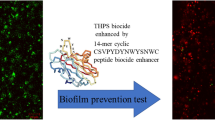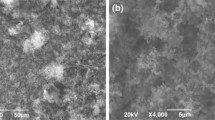Abstract
Microbiologically influenced corrosion (MIC), or microbial biocorrosion, is caused directly by microbial metabolic activities/products or induced by microbial biofilm’s damage of a protective film that exposes a solid surface to a pre-existing corrosive environment. MIC causes billions of dollars of losses in various industrial processes, especially in oil and gas and water utilities. The mitigation of problematic industrial microbes typically relies on biocides whose discharges can cause environmental problems. Thus, more effective biocide applications are desired to minimize environmental impact. D-Limonene, a citrus peel oil, generally regarded as safe (GRAS), was used to enhance the popular biodegradable tetrakis hydroxymethyl phosphonium sulfate (THPS) biocide. An oilfield mixed-culture biofilm was grown anaerobically in enriched artificial seawater containing C1018 carbon steel coupons for 7 days at 37 °C. One hundred ppm (w/w) D-limonene reduced general heterotrophic bacteria (GHB) and acid-producing bacteria (APB) effectively, leading to 5.4-log and 6.0-log reductions in sessile GHB and APB cell counts, respectively, compared to no treatment control. The combination of 100 ppm D-limonene + 100 ppm THPS achieved extra 1.0-log SRB, 0.6-log GHB and 0.5-log APB reductions in sessile cell counts, which led to extra 58% reduction in microbial corrosion mass loss (1.2 vs. 0.5 mg/cm2) and extra 30% reductions in maximum pit depth (11.5 vs. 8.1 µm), compared to 100 ppm THPS-only treatment. Linear polarization resistance and potentiodynamic polarization (PDP) corrosion data supported mass loss and pitting data.
Graphical abstract
Mixed-culture biofilms on carbon steel coupons after 7 day incubation at 37 °C showing enhanced biocide treatment outcome using D-limonene + THPS: A no treatment, B 100 ppm D-limonene, C 100 ppm THPS, D 100 ppm D-limonene + 100 ppm THPS.










Similar content being viewed by others
References
Wolodko J, Haile T, Khan F et al (2018) Modeling of microbiologically influenced corrosion (MIC) in the oil and gas industry—past, present and future. NACE International
Unsal T, Jia R, Kumseranee S et al (2019) Laboratory investigation of microbiologically influenced corrosion of carbon steel in hydrotest using enriched artificial seawater inoculated with an oilfield biofilm consortium. Eng Fail Anal 100:544–555
Street CN, Gibbs A (2010) Eradication of the corrosion-causing bacterial strains Desulfovibrio vulgaris and Desulfovibrio desulfuricans in planktonic and biofilm form using photodisinfection. Corros Sci 52:1447–1452
Bhat S, Kumar B, Prasad S, Katarki M (2011) Failure of a new 8-in pipeline from group gathering station to central tank farm. Mater Perform 50:50–54
Skovhus TL, Eckert RB, Rodrigues E (2017) Management and control of microbiologically influenced corrosion (MIC) in the oil and gas industry—Overview and a North Sea case study. J Biotechnol 256:31–45
Sharma M, Liu H, Chen S et al (2018) Effect of selected biocides on microbiologically influenced corrosion caused by Desulfovibrio ferrophilus IS5. Sci Rep 8:16620
Wang D, Liu J, Jia R et al (2020) Distinguishing two different microbiologically influenced corrosion (MIC) mechanisms using an electron mediator and hydrogen evolution detection. Corros Sci 177:108993
Rasheed PA, Jabbar KA, Rasool K et al (2019) Controlling the biocorrosion of sulfate-reducing bacteria (SRB) on carbon steel using ZnO/chitosan nanocomposite as an eco-friendly biocide. Corros Sci 148:397–406
Al-Nabulsi KM, Al-Abbas FM, Rizk TY, Ala’a Edin MS (2015) Microbiologically assisted stress corrosion cracking in the presence of nitrate reducing bacteria. Eng Fail Anal 58:165–172
Kip N, van Veen JA (2015) The dual role of microbes in corrosion. ISME J 9:542–551
Wang D, Ramadan M, Kumseranee S et al (2020) Mitigating microbiologically influenced corrosion of an oilfield biofilm consortium on carbon steel in enriched hydrotest fluid using 2,2-dibromo-3-nitrilopropionamide (DBNPA) enhanced by a 14-mer peptide. J Mater Sci Technol 57:146–152
Videla HA (2002) Prevention and control of biocorrosion. Int Biodeterior Biodegrad 49:259–270
Jia R, Yang D, Li Y et al (2017) Mitigation of the Desulfovibrio vulgaris biofilm using alkyldimethylbenzylammonium chloride enhanced by d-amino acids. Int Biodeterior Biodegrad 117:97–104
Mah TF, O’Toole GA (2001) Mechanisms of biofilm resistance to antimicrobial agents. Trends Microbiol 9:34–39
Kahrilas GA, Blotevogel J, Stewart PS, Borch T (2015) Biocides in hydraulic fracturing fluids: a critical review of their usage, mobility, degradation, and toxicity. Environ Sci Technol 49:16–32
Gorman SP, Scott EM, Russell AD (1980) Antimicrobial activity, uses and mechanism of action of glutaraldehyde. J Appl Bacteriol 48:161–190
Stipaničev M, Turcu F, Esnault L et al (2013) Corrosion behavior of carbon steel in presence of sulfate-reducing bacteria in seawater environment. Electrochim Acta 113:390–406
Lekbach Y, Xu D, El Abed S et al (2018) Mitigation of microbiologically influenced corrosion of 304L stainless steel in the presence of Pseudomonas aeruginosa by Cistus ladanifer leaves extract. Int Biodeterior Biodegrad 133:159–169
Lekbach Y, Dong Y, Li Z et al (2019) Catechin hydrate as an eco-friendly biocorrosion inhibitor for 304L stainless steel with dual-action antibacterial properties against Pseudomonas aeruginosa biofilm. Corros Sci 157:98–108
Wang J, Li C, Zhang X et al (2019) Corrosion behavior of Aspergillus niger on 7075 aluminum alloy and the inhibition effect of zinc pyrithione biocide. J Electrochem Soc 166:G39–G46
Jia R, Yang D, Dou W et al (2019) A sea anemone-inspired small synthetic peptide at sub-ppm concentrations enhanced biofilm mitigation. Int Biodeterior Biodegrad 139:78–85
Li Y, Jia R, Al-Mahamedh HH et al (2016) Enhanced biocide mitigation of field biofilm consortia by a mixture of D-amino acids. Front Microbiol 7:896
Moufida S, Marzouk B (2003) Biochemical characterization of blood orange, sweet orange, lemon, bergamot and bitter orange. Phytochemistry 62:1283–1289
Sun J (2007) D-Limonene: safety and clinical applications. Altern Med Rev 12:259
Zhang Z, Vriesekoop F, Yuan Q, Liang H (2014) Effects of nisin on the antimicrobial activity of D-limonene and its nanoemulsion. Food Chem 150:307–312
Miguel MG (2010) Antioxidant and anti-inflammatory activities of essential oils: a short review. Molecules 15:9252–9287
Settanni L, Palazzolo E, Guarrasi V et al (2012) Inhibition of foodborne pathogen bacteria by essential oils extracted from citrus fruits cultivated in Sicily. Food Control 26:326–330
Chikhoune A, Hazzit M, Kerbouche L et al (2013) Tetraclinis articulata (Vahl) masters essential oils: chemical composition and biological activities. J Essent Oil Res 25:300–307
Kijkla P, Wang D, Mohamed ME et al (2021) Efficacy of glutaraldehyde enhancement by d-limonene in the mitigation of biocorrosion of carbon steel by an oilfield biofilm consortium. World J Microbiol Biotechnol 37:174
Jia R, Wang D, Jin P et al (2019) Effects of ferrous ion concentration on microbiologically influenced corrosion of carbon steel by sulfate reducing bacterium Desulfovibrio vulgaris. Corros Sci 153:127–137
Sutton S (2010) The most probable number method and its uses in enumeration, qualification, and validation. J Valid Technol 16:35–38
ASTM G1-03 (2017) e1, 2017. Standard Practice for Preparing, Cleaning and Evaluating Corrosion Test Specimens. ASTM International, West Conshohocken, Pennsylvania. http://www.astm.org
Han Y, Sun Z, Chen W (2019) Antimicrobial susceptibility and antibacterial mechanism of limonene against Listeria monocytogenes. Molecules 25:33
Bajpai P (2015) The control of microbiological problems. Pulp Paper Ind, pp 103–195
Talbot RE, Larsen J, Sanders PF (2000) Experience with the use of tetrakishydroxymethylphosphonium sulfate (THPS) for the control of downhole hydrogen sulfide. NACE International
Sharma M, Menon P, Voordouw J et al (2018) Effect of long term application of tetrakis(hydroxymethyl)phosphonium sulfate (THPS) in a light oil-producing oilfield. Biofouling 34:605–617
Senthilmurugan B, Radhakrishnan JS, Poulsen M et al (2019) Microbially induced corrosion in oilfield: microbial quantification and optimization of biocide application. J Chem Technol Biotechnol 94:2640–2650
Martino PD, Martino PD (2021) Ways to improve biocides for metalworking fluid. AIMS Microbiol 7:13–27
Jin Y, Li Z, Zhou E et al (2019) Sharing riboflavin as an electron shuttle enhances the corrosivity of a mixed consortium of Shewanella oneidensis and Bacillus licheniformis against 316L stainless steel. Electrochim Acta 316:93–104
Jia R, Tan JL, Jin P et al (2018) Effects of biogenic H2S on the microbiologically influenced corrosion of C1018 carbon steel by sulfate reducing Desulfovibrio vulgaris biofilm. Corros Sci 130:1–11
Liu H, Gu T, Zhang G et al (2018) Corrosion of X80 pipeline steel under sulfate-reducing bacterium biofilms in simulated CO2-saturated oilfield produced water with carbon source starvation. Corros Sci 136:47–59
Acknowledgements
PTT Exploration and Production (Thailand) and Saudi Aramco provided financial support to this work.
Author information
Authors and Affiliations
Corresponding author
Ethics declarations
Conflict of interest
The authors declare that they have no conflict of interests.
Additional information
Publisher's Note
Springer Nature remains neutral with regard to jurisdictional claims in published maps and institutional affiliations.
Rights and permissions
About this article
Cite this article
Unsal, T., Wang, D., Kijkla, P. et al. Food-grade D-limonene enhanced a green biocide in the mitigation of carbon steel biocorrosion by a mixed-culture biofilm consortium. Bioprocess Biosyst Eng 45, 669–678 (2022). https://doi.org/10.1007/s00449-021-02685-6
Received:
Accepted:
Published:
Issue Date:
DOI: https://doi.org/10.1007/s00449-021-02685-6




